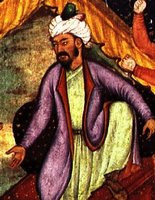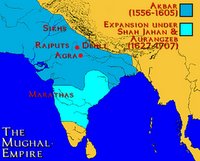A Short History of the Golden Triangle
 No trip to India is complete without experiencing the Golden Triangle tour of northern India. The Golden Triangle is comprised of Delhi, the capital of India, Jaipur, the capital of Rajasthan, and Agra, the home of the Taj Mahal. Our daughter Karen was finishing her fourth week visit to India and we wanted her to see the Taj Mahal while in India. We had not seen the Taj either, so we were keen to make the journey north as well.
No trip to India is complete without experiencing the Golden Triangle tour of northern India. The Golden Triangle is comprised of Delhi, the capital of India, Jaipur, the capital of Rajasthan, and Agra, the home of the Taj Mahal. Our daughter Karen was finishing her fourth week visit to India and we wanted her to see the Taj Mahal while in India. We had not seen the Taj either, so we were keen to make the journey north as well. But first a bit of northern India history to put the whole Golden Triangle in context. The Taj Mahal, for example, is a mausoleum built by the Mughal ruler Shah Jahan to honor his favorite wife, Mumtaz Mahal, who died at the age of 39 while giving birth to her fourteenth child in 1631.
But first a bit of northern India history to put the whole Golden Triangle in context. The Taj Mahal, for example, is a mausoleum built by the Mughal ruler Shah Jahan to honor his favorite wife, Mumtaz Mahal, who died at the age of 39 while giving birth to her fourteenth child in 1631.Invasion of northern India from outsiders had been ongoing for centuries. Our story starts with the Afghani, Muhammad of Ghur, who ousted the last Hindu
 king Prithviraj Chauhan in 1192. Muhammad of Ghur then headed home and left the keys of the kingdom to his viceroy Qutbuddin Aibak. It was Qutbuddin Aibak who in 1199 laid the foundation of the Qutab Minar, a 239 ft. sandstone tower of Indo-Islamic architectural wonder of ancient India which now is a must see tourist stop in Delhi.
king Prithviraj Chauhan in 1192. Muhammad of Ghur then headed home and left the keys of the kingdom to his viceroy Qutbuddin Aibak. It was Qutbuddin Aibak who in 1199 laid the foundation of the Qutab Minar, a 239 ft. sandstone tower of Indo-Islamic architectural wonder of ancient India which now is a must see tourist stop in Delhi. The Sultans of Delhi had a long run ruling India until 1526, when the last Sultan of Delhi was defeated by Babar (picture left) of the Mughal Empire. Babar moved the capital from Delhi to Agra. After Babar’s death in 1530, his son Humayun took over as ruler. Humayun's son Akbar succeeded his father and substantially expanded the empire and ruled in many enlightened ways.
The Sultans of Delhi had a long run ruling India until 1526, when the last Sultan of Delhi was defeated by Babar (picture left) of the Mughal Empire. Babar moved the capital from Delhi to Agra. After Babar’s death in 1530, his son Humayun took over as ruler. Humayun's son Akbar succeeded his father and substantially expanded the empire and ruled in many enlightened ways.Akbar was succeeded by his favorite son, Jahangir, who ruled the empire from 1605 to 1628. Jahangir was succeeded by Shah Jahan, who ruled from 1628 to 1658. Shah Jahan moved the capital from Agra back to Delhi before building the Taj Mahal.
 A succession crises occurred near the end of Shah Jahan's reign. The conflict between Shah Jahan's sons ended with the victory of Aurangzeb, who executed his three older brothers and imprisoned his father for the last eight years of his life.
A succession crises occurred near the end of Shah Jahan's reign. The conflict between Shah Jahan's sons ended with the victory of Aurangzeb, who executed his three older brothers and imprisoned his father for the last eight years of his life.Aurangzeb, who ruled from 1658 to 1707, watched his empire expand and then finally fall apart because of internal rebellion and the appearance of a new ruler in India, Great Britain.

0 Comments:
Post a Comment
<< Home